Trying to decide between the 22 Creedmoor vs 22-250 Remington cartridges for coyote and even big game hunting? Here’s what you need to know about them.
The 22-250 Remington has long been one of America’s premier predator hunting cartridge’s and remains a favorite for hunters desiring its flat shooting and hard hitting performance on coyotes and the like.
As good as it is though, the 22-250 Remington suffers in a few key areas, like wind deflection. With this in mind, many serious hunters have looked for alternatives to the venerable 22-250 in more recent years to gain every edge possible afield.
Specifically, the folks at Horizon Firearms and Hornady partnered to develop the new, hot rod 22 Creedmoor for those hunters who wanted more even more performance than the venerable 22-250 could deliver.
The 22-250 Remington has reigned atop the heap of varmint cartridges for decades and, as the saying goes, you should never strike at the king unless you’re sure you can kill him. Is the 22 Creedmoor just the latest round to miss the mark and fall by the wayside? Or does this new cartridge bring additional capability to the table that the 22-250 Remington lacks?
With those things in mind, I investigate the 22 Creedmoor vs 22-250 Remington debate in detail in this article in order to provide some insight into which rifle cartridge is ideally suited for your specific hunting situation.
Table of Contents
History Of The 22 Creedmoor & 22-250 Remington
We’ll start off with the 22-250 Remington.
Developed all the way back in 1913, the .250/3000 Savage (sometimes called the .250-3000 Savage) was the brainchild of Charles Newton and was the first mass produced rifle cartridge to break the 3,000fps barrier.
That was incredible performance at the time, but other designers recognized the potential for even faster velocities by necking the 250 Savage down to shoot even smaller diameter and lighter bullets than the 87gr, .257″ projectiles it used.
Specifically, wildcatters necked the Savage case down to .22 caliber to build a round known as the .22 Varminter. The Varminter was widely popular and nearly matched the performance of the much larger 220 Swift.
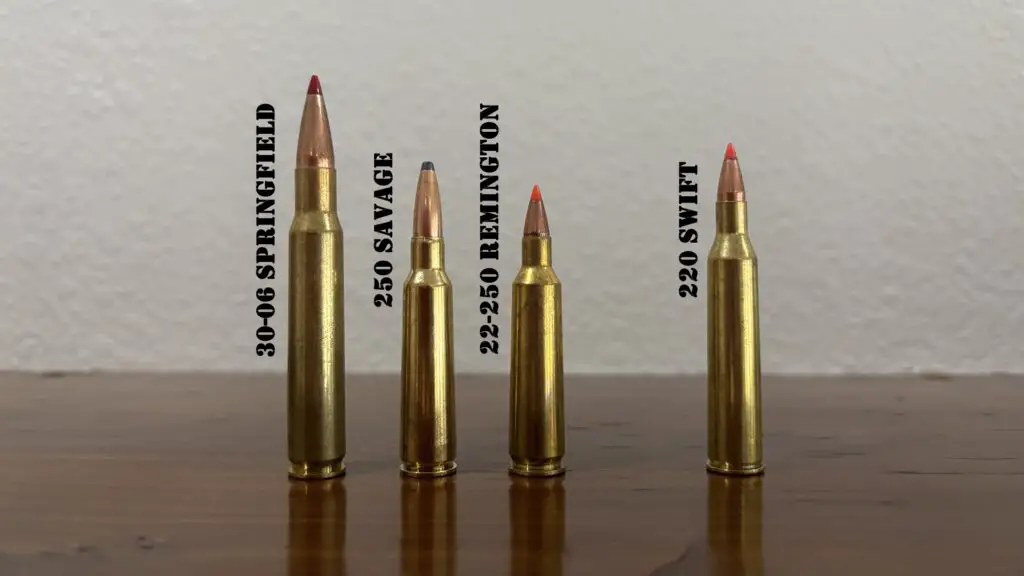
Leadership at the Remington Arms Company saw an opportunity in the market and standardized the Varminter as the 22-250 Remington in 1965.
Capable of flinging 50gr .22 caliber bullets at velocities in excess of 3,700 feet per second (and firing lighter bullets over 4,000fps), the 22-250 also developed a reputation for an almost laser flat trajectory, devastating performance on thin skinned animals, mild recoil, and exceptional accuracy.
Like they hoped, the cartridge turned into a massive commercial success for Big Green as varmint hunters snatched up the factory 22-250 ammo and Model 700 rifles the company produced for their new round.
A 55-grain bullet at approximately 3,700fps is a pretty standard load for the 22-250 these days.
As good as the 22-250 Remington is though, hunters and shooters have long sought an alternative that further improves on the performance of the old Remington cartridge.
In particular, the 22-250 Remington typically utilizes lighter, low BC bullets that don’t do very well in windy conditions.
For example, I have a friend who uses a 22-250 for culling game like springbok and blesbok in the open, windswept hills of South Africa’s Free State Province.
He wants to minimize meat loss on those animals and to simplify his recovery efforts afterwards, so a 55gr V-Max from his 22-250 is his load of choice and he exclusively shoots those animals in the head.
That set-up works great for his purposes and he can often take several animals from the same herd from around 200-250 yards away. However, things can get tricky when trying to make a headshot on an animal at that range if the wind picks up (which often happens).
Furthermore, those low BC varmint bullets the 22-250 uses also slow down rapidly and simply don’t pack as much punch at longer range as many hunters wish they did.
For instance, a man named Derrick Ratliff made a less than ideal shot on a coyote with his 22-250 while participating in a coyote hunting contest many years ago. As sometimes happens with a marginal shot like that, the creature spun around in a circle a few times, then took off.

They eventually found the coyote, but the time they spent looking for it made Derrick & his partner late to weigh-in, which cost them a not insignificant amount of prize money.
The incident spurred Derrick to search for another cartridge that would have dropped that coyote in its tracks.
That’s easier said than done: coyotes are not very big and Derrick likens shooting one to trying to hit a moving two liter soda bottle turned sideways at an uncertain range. Plus, even though they’re not especially large creatures, coyotes are also pretty resilient and aren’t always easy to instantly put down, especially with a marginal shot.
Instead of shooting a light, fast bullet like the 22-250, Derrick wanted something that would shoot heavy bullets at a slower, though still screaming fast velocity that would perform better in the wind, hit significantly harder downrange, yet would also still have a flat trajectory.
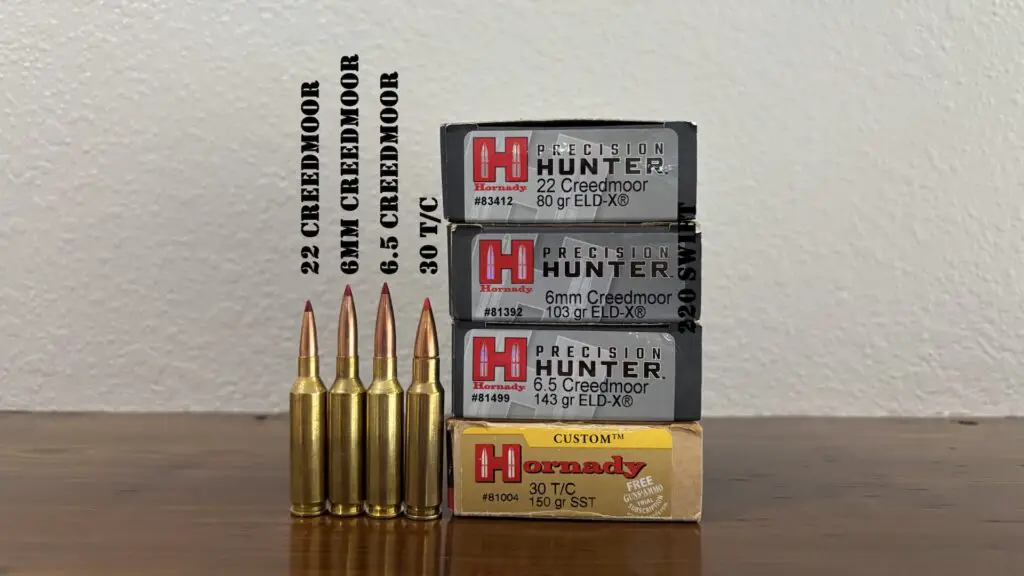
He tried out a number of potential solutions before eventually finding one that worked better than the rest: a 6.5 Creedmoor necked down to 22 caliber and shooting 75gr Hornady A-Max bullets.
Not only was that combination of a 75gr A-Max in excess of 3,500fps absolutely deadly on coyotes, but Derrick also observed that it was still super flat shooting, really bucked the wind, and had very mild recoil.
Though it was not his primary goal in developing that new wildcat cartridge, he also discovered it delivered fantastic terminal performance on deer sized game!
Convinced he found the solution to his problem, Derrick and the rest of the folks at Horizon Firearms spent the better part of the next decade refining their wildcat cartridge.
They eventually partnered with Hornady for help tweaking load development, shepherding it through the SAAMI standardization process, and getting it to the market.
Their efforts eventually bore fruit when SAAMI formally accepted the former wildcat round in January 2024 as the 22 Creedmoor.
Hornady initially introduced two factory loads for the 22 Creedmoor shooting 80gr ELD-X and an 80gr ELD Match bullets at an advertised velocity of 3,285fps.
Now let’s dive into the details of how these two rounds stack up next to each other.
22-250 vs 22 Creedmoor Cartridge Sizes
While they look similar in some ways at first glance, there are some significant differences in the physical dimensions of the .22-250 Remington and the 22 Creedmoor.
First, though both the 22-250 and 22 Creedmoor fire .224″ (5.7mm) diameter bullets, the two cartridges are best suited for dramatically different bullet weights and types.
This is largely a function of the rifling twist rates most common in rifles chambered for each cartridges.
For instance, the 22 Creedmoor was designed from the start to use really long, heavy, high BC bullets and has a SAAMI specified twist rate of 1:8″.
The 22 Creedmoor works particularly well with the 80gr ELD Match and 80gr ELD-X from Hornady (both have a G1 BC of .485).
That cartridge will also work with other really long and heavy .22 caliber bullets like the 62gr ELD-VT (.395 BC), 77gr Sierra Tipped MatchKing (.420 BC), and the Berger 80.5gr Fullbore (.441 BC).
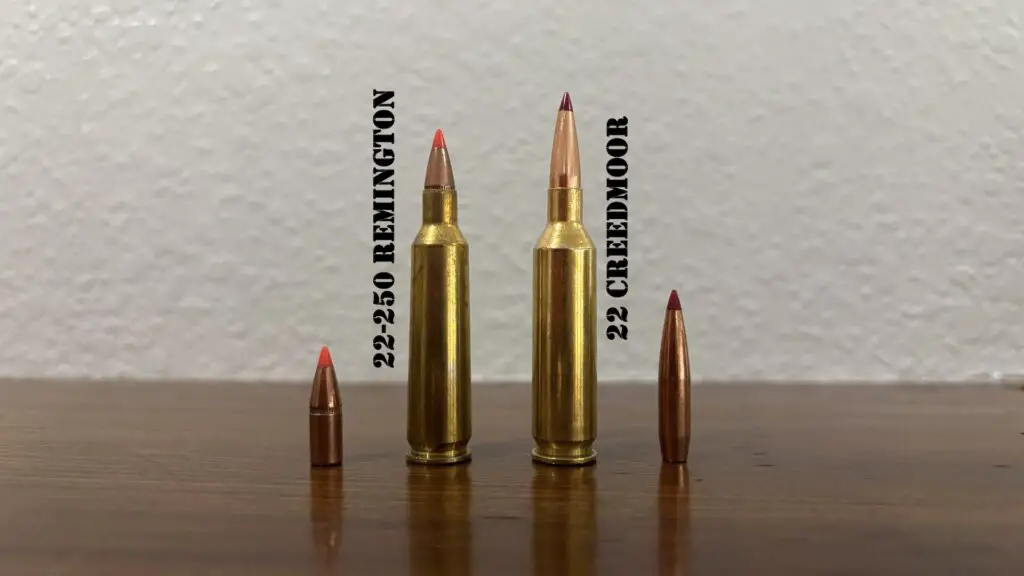
All of those bullets should work great with an off the shelf 22 Creedmoor rifle under a wide spectrum of conditions. Other bullets, like the 77gr Barnes LRX, Berger 85.5gr Long Range Hybrid Target, Hornady 88gr ELD Match, Berger 90gr VLD Target, and Hornady 90gr A-Tip can also potentially work, but may require a barrel with a faster 1:7.5″ or 1:7″ twist rate under certain conditions for optimum performance.
On the other hand, the 22-250 Remington has a much slower SAAMI specified twist rate of 1:14″.
That twist rate makes the cartridge best suited for using lighter bullets. Therefore, bullets in the 35-55 grain range are most popular for the .22-250 Remington.
We’ll discuss this more later, but not all 22-250 Remington rifles use a 1:14″ twist rate. For instance, some modern production 22-250 rifles from Browning and Bergara have 1:9″ twist rates and can utilize heavier bullets.
Some companies, like Horizon firearms, will even chamber their 22-250 rifles with a 1:8″ twist rate.
Though handloaders can potentially utilize heavier bullets for the cartridge when paired with a rifle with the appropriate twist rate, the vast majority of .22-250 Remington factory loads shoot lower BC 35gr, 40gr, 50gr, 55gr, and 64gr bullets. This is due to the larger numbers of 22-250 rifles with a slower twist rate out there.
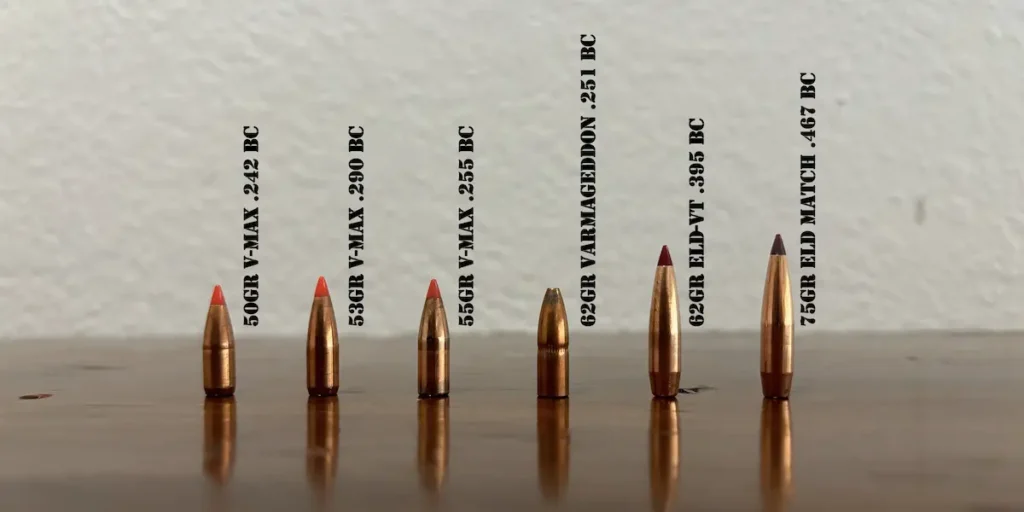
Bullets like the 50gr Hornady V-Max (.242 BC), 50gr Barnes TSX (.197 BC), 55gr Varmageddon (.255 BC) and 64gr Winchester Power Point (.251 BC) are all pretty representative of projectiles common for the 22-250 in factory ammunition.
True, heavier and more aerodynamic bullets are available for the 22-250 Remington and the cartridge can shoot an 80-grain bullet. For instance, Copper Creek load ammunition for the 22-250 using bullets like the 80gr Berger VLD (.455 BC), 88gr Hornady ELD Match (.545 BC), and the Hornady 90gr A-Tip (.575 BC).
The catch is those bullets all require either a 1:8 or even a 1:7 minimum twist rate to stabilize. Additionally, those bullets are so large they require a longer cartridge overall length as long as 2.55″.
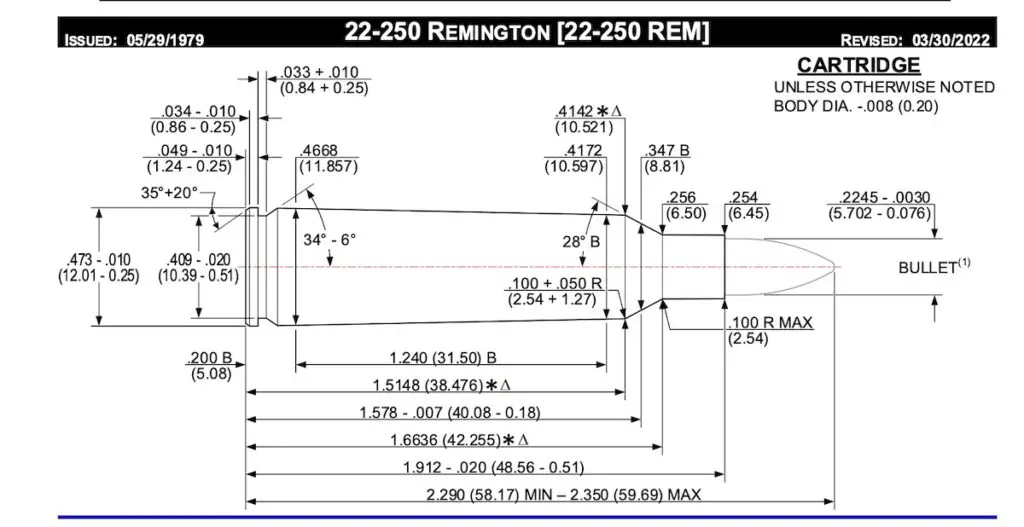
That brings me to my next point: the 22 Creedmoor has a longer SAAMI specified cartridge overall length of 2.7″ vs just 2.35″ for the 22-250 Remington.
Even those loads I listed earlier for the 22 Creedmoor using super heavy 90gr bullets from Copper Creek for the 22 Creedmoor have a maximum overall of 2.66″ or less, which fits comfortably within the overall length of the cartridge.
However, since SAAMI specifies a 2.35″ maximum overall length for the 22-250, the really long bullets sometimes require a special chamber design and/or longer rifle magazine for optimal performance and function in certain rifles.
To be fair, some rifles can accommodate bullets this long. As an example, the Bergara Crest Carbon in 22-250 utilizes a 6.5 Creedmoor sized magazine and I had no issues firing handholds 2.5″ long utilizing the 62gr ELD-VT from that rifle.
Not every 22-250 Remington rifle can do that though.
But I can hear somebody thinking right now:
John, I hear what you’re saying, but what if I have a 22-250 rifle with a fast 1:7 or 1:8 twist rate and a chamber/magazine that can accommodate ammunition with those bullets?
Surely it can hang with the 22 Creedmoor, right?
Well, not quite.
The 22 Creedmoor also has a larger case capacity than the 22-250.
While both cartridges have similar sized cases, the 22 Creedmoor has a slightly larger SAAMI spec case head diameter (.470″ vs .4668″), much less body taper, and a slightly longer case (1.92″ vs 1.912″).
Additionally, the 22 Creedmoor has a 30 degree shoulder angle while the 22-250 Remington has a 28 degree shoulder angle.
Add it all up and the 22 Creedmoor has about 15% more case capacity than the 22-250 Remington.
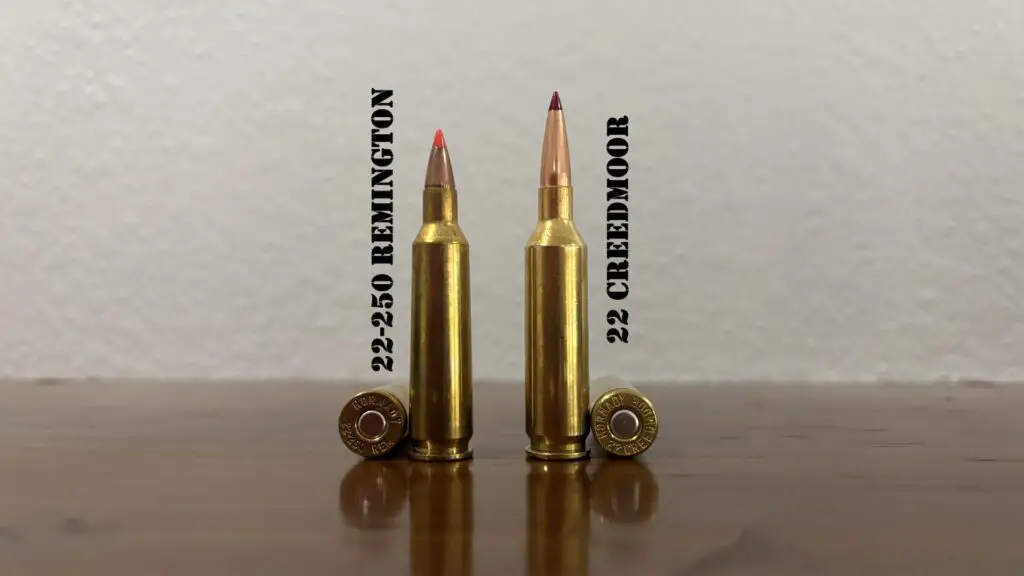
The 22 Creedmoor also has quite a bit more head height than the 22-250 Remington.
Head height is the amount of space available for the bullet outside the case while staying within SAAMI specifications for the cartridge. Put simply, more head height facilitates the use of very long, aerodynamic bullets without requiring them to be seated so deeply into the case they intrude into the powder column.
Even though the 22 Creedmoor has a slightly longer case, the fact that it has a longer overall length results in a much larger head height of .78″ vs .438″ for the 22-250.
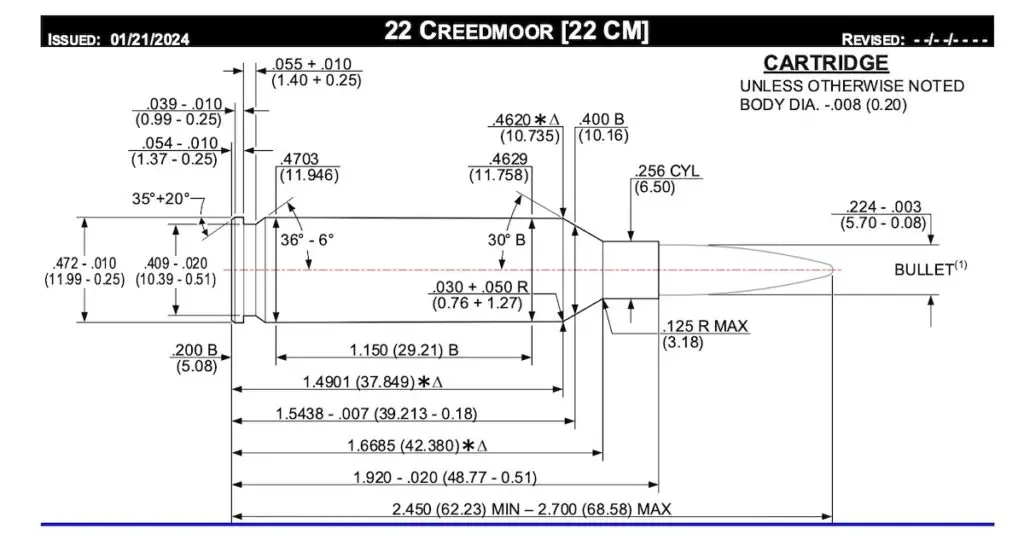
Finally, the 22-250 Remington actually has a slightly higher SAAMI maximum average pressure of 65,000psi vs 62,000psi for the 22 Creedmoor.
Note: while the case capacity listed below is a good indication of 22-250 Remington and 22 Creedmoor powder capacity, exact case capacities will vary slightly according to the brand of brass used.
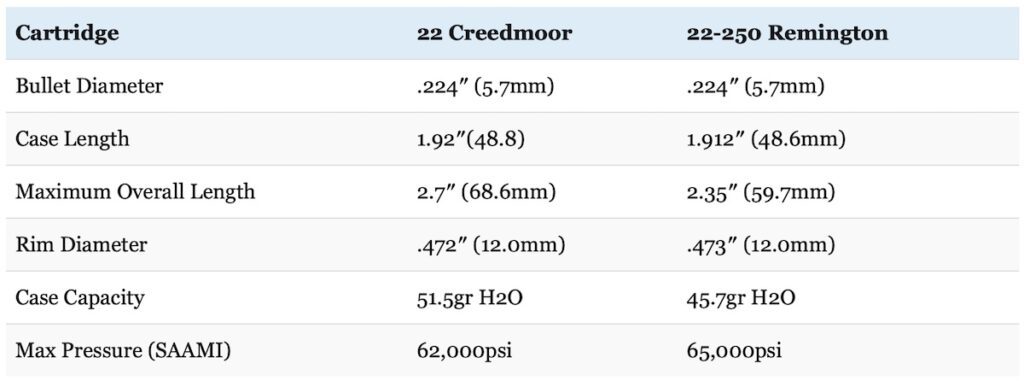
I obtained 51.5gr H20 for 22 Creedmoor case capacity and 45.7gr H2O 22-250 case capacity by measuring the powder capacity of 5 individual 22 Creedmoor and 22-250 expended cases (Hornady brass for both) and averaging their measured capacity.
For what it’s worth, Chuck Hawks lists an even lower 22-250 case capacity of 44.6gr H2O for Winchester brass and Joseph von Benedikt lists a slightly higher figure of 52.6gr of water for 22 Creedmoor case capacity in his Rifle Shooter Magazine article on the round.
With those figures in mind, I think it’s pretty safe to state the 22 Creedmoor has 6-8 grains more case capacity than the 22-250.
That extra powder capacity means that, all other things equal, the 22 Creedmoor can fire the same weight bullet faster than the 22-250.
22-250 vs 22 Creedmoor Ballistics
So how does the 22 Creedmoor stack up against the 22-250 on the ballistics side of things?
To illustrate this, we’ll compare the 80gr ELD-X 22 Creedmoor load (the ELX-X and ELD Match loads for this cartridge have the exact same ballistics) to a couple of popular varmint loads for the 22-250 Remington. The 22 Creedmoor doesn’t shoot that bullet quite as fast as the 22-250 shoots lighter bullets, but as you’ll see shortly, that’s still a high velocity load that performs incredibly well.
First, we’ll use a run of the mill 55gr 22-250 Remington load from Hornady’s Varmint Express line (shooting a 55gr V-Max bullet with a .255 BC). That’s a pretty typical 22-250 predator load and is similar to what you’ll often see from other companies like Federal, Nosler, Remington, and Winchester.
We’ll also use two high performance 22-250 loads from Hornady’s Superformance Varmint line: one shooting a 35gr V-Max with a .170 BC at a blazing fast 4,450fps and another shooting 50gr V-Max with a .242 BC at a smoking 4,000fps.
The 50gr V-Max load is about as good as you’ll find for a high performance 22-250 Remington factory load and gives close to the best balance of trajectory, wind deflection, and retained energy downrange that you’ll get from a factory load for the cartridge.
I’ll also compare another 22-250 Remington load using a 80gr ELD Match bullet. Hornady doesn’t offer that bullet in a factory load for the 22-250, but Copper Creek does sell this as a custom handload for the cartridge.
Important to note that, like I mentioned earlier, the 80gr ELD-X bullet is really long and has a specified cartridge overall length of 2.5″ when loaded in the 22-250, which is too long to fit in typical 22-250 rifle magazines. It also requires a faster 1:8″ twist rate.
This is why Hornady doesn’t offer it as a factory load, but it will work in a 22-250 rifle set-up properly.
All data below is for a 200 yard zero and out of a rifle with a 24″ long barrel.
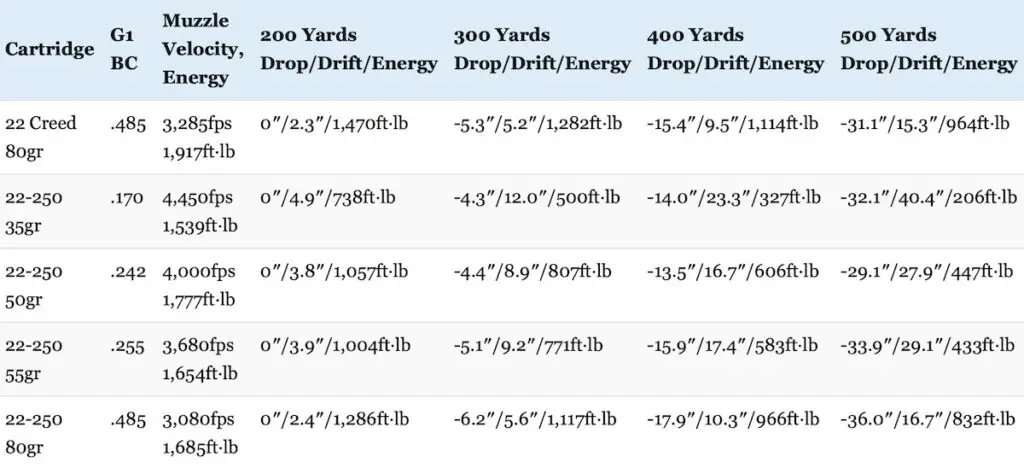
First, those three 22-250 loads firing varmint bullets all start out with a faster muzzle velocity, but all have a much lower BC than 80gr ELD-X the 22 Creedmoor uses.
The end result is those four loads are all neck and neck in the trajectory department. The 50gr V-Max is a little flatter shooting than the rest, but is still only hitting about 2″ higher than the 22 Creedmoor at 500 yards.
The 22 Creedmoor also has a slightly flatter trajectory than the 35gr NTX and the 55gr V-Max, even though those 22-250 loads start off with a muzzle velocity advantage of 1,65fps and nearly 400fps respectively!
Yes: even that 22-250 load with a muzzle velocity over 1,000fps faster has basically the same trajectory as the 22 Creedmoor out to 500 yards!
Additionally, the 22 Creedmoor blows away all three varmint bullets in the wind deflection category and requires a little more than half the wind hold of the 50gr and 55gr V-Max loads and just over a third of the wind hold for the 35gr NTX.
Heck, the 22 Creedmoor has less wind deflection at 500 yards than those three 22-250 varmint loads do at 400 yards!
Furthermore, that 80gr ELD-X puts a whole lot more energy on target than the 22-250. That’s true at the muzzle and the difference only increases with range and that load retains over twice the energy of the V-Max loads and over 4x the kinetic energy as the NTX load at 500 yards!
So the 22 Creedmoor has virtually the same trajectory, but has much better performance in the wind and retains much more energy than the 22-250 downrange.
To illustrate this point further, if you fired those four loads at the exact same time at the same target, the 80gr ELD-X will pass the 55gr V-Max in the air around the 300 yard mark, will pass the 35gr NTX around 450 yards, and will pass the 50gr V-Max around 550 yards downrange.
Add it all up and it’s easy to see why the 22 Creedmoor appeals to so many hunters: it gives you the things people like about the 22-250 (especially that flat trajectory), but dramatically improves upon the performance of the 22-250 in the wind and effects on target categories when the 22-250 is using a varmint bullet.
That’s a great example of what using a much higher BC bullet will do for you and I’ll share some gel test results and examples from the range to illustrate those points shortly.
Before we move onto that though, I want to talk briefly about the 22-250 load with the 80gr ELD-X.
Like I mentioned earlier, the 22 Creedmoor has a larger case capacity that will hold more powder. That means it can push the same weight bullet faster.
In this particular case, the 22 Creedmoor has about a 200fps muzzle velocity advantage when both are shooting the same weight bullet.
That’s more or less the difference in performance between the 308 and the 30-06 or the 30-06 and the 300 Win Mag with typical factory loads. In other words, the 22 Creedmoor still has a significant edge over the 22-250 in performance.
To be fair though, that 22-250 load performs much better than the 22-250 varmint loads in the wind deflection and retained energy categories, though it lags a little in the trajectory department.
It’s also worth noting that’s a pretty hot handled for the 22-250 and I’m comparing it to a more sedate factory load Hornady isn’t standing on too hard.
For what it’s worth, Copper Creek also lists a load for the 22 Creedmoor shooting 80gr ELD-X at 3,400fps!
So yes, users can dramatically improve the performance of the 22-250 at extended range with custom 22-250 Remington rifles, magazines, and handloads designed to accommodate higher BC bullets and fire them with a high degree of accuracy.
They’ll still fall a little short of 22 Creedmoor ballistics, but will come close. Taking the additional step of bumping up to a 22-250 Ackley Improved (aka 22-250 AI) will further narrow the gap between it and the 22 Creedmoor.
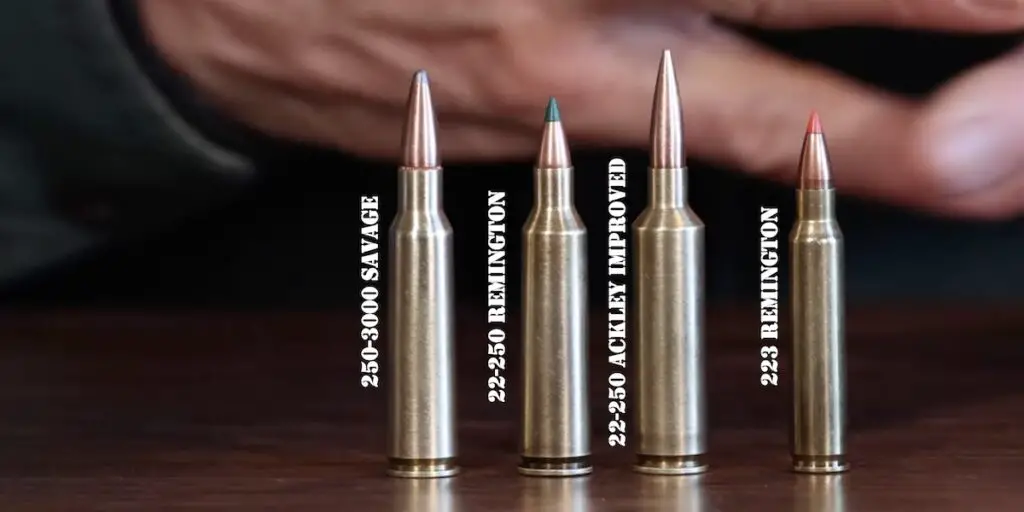
Or they can skip all that hassle and just get a factory 22 Creedmoor rifle and use factory ammunition.
Before we move on, I do want to acknowledge that Hornady has gotten in hot water for some of their ammo (namely for the 7mm PRC) failing to achieve anywhere near their published velocities. That has not been my experience with the 22 Creedmoor and all the ammo I’ve shot for it has achieved velocities very close to what Hornady has claimed out of my rifle (which has a 24″ barrel).
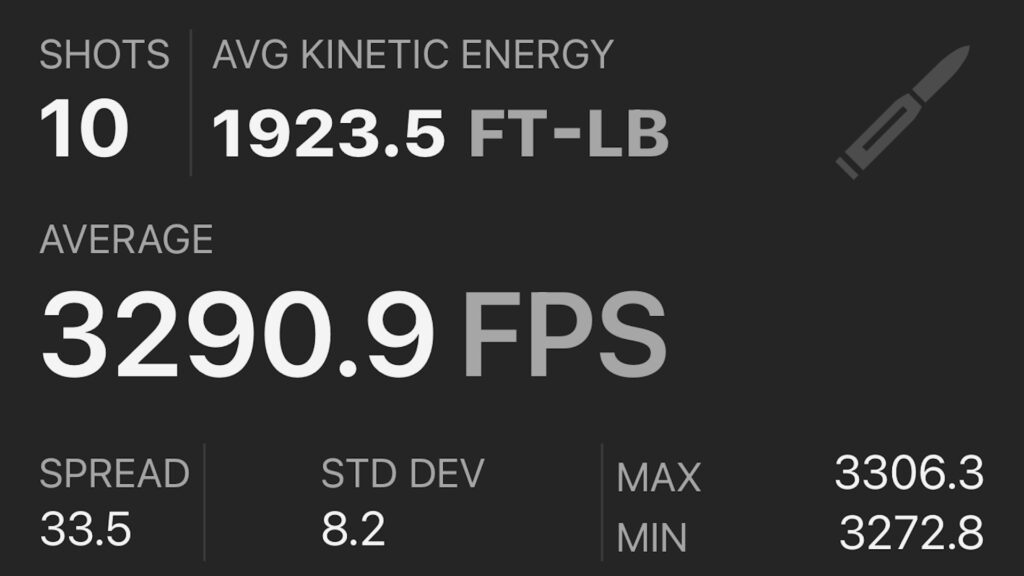
Circling back to comparing 22 Creedmoor vs 22-250 ballistics, a 3-4″ difference in the point of impact from wind deflection (which is about the advantage the 80gr ELD-X from the 22 Creedmoor has over the high performance 50gr V-Max at just 300 yards) could easily be the difference between hit to the vitals that drops a coyote in its tracks vs a hit that’s not immediately lethal that allows the coyote to escape.
Not only do those factors make it easier to hit a target at long range, but the 22 Creedmoor also simply hits a whole lot harder, which can make a big difference in minimizing wounding loss and just quickly killing animals.
This was on display during a recent trip to the range where I shot my 22 Creedmoor and 22-250 out to 500 yards.
It was somewhat windy that day (not terrible, but not calm either), but I didn’t have any issues hitting targets even out at 400 and 500 yards with the 22 Creedmoor. In fact, I took my first shot of the day with that rifle at a small, circular plate at 400 yards and drilled it almost dead center.
The range officer was impressed and told me he’d never seen anyone do that with their first shot on that target.
Now, I was shooting the 50gr V-Max load out of the 22-250 on that same trip. My rifle (a Bergara Crest Carbon) really shoots that ammo well.
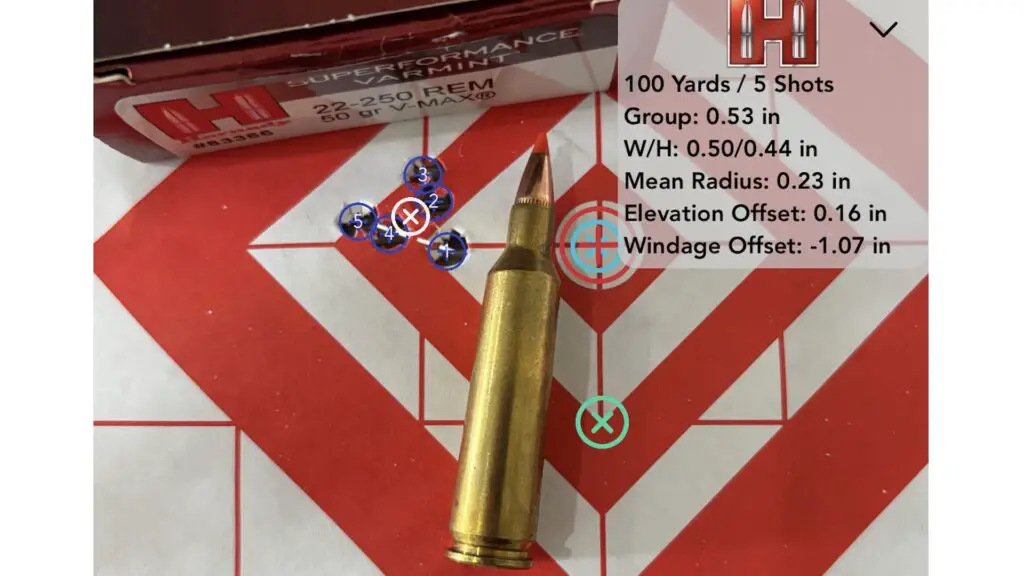
The 200 and 300 yard targets were a piece of cake, but I had to work harder to hit those targets at 400 and 500 yards with the 22-250. Specifically, I observed about a foot of wind deflection at 500 yards with that 50gr V-Max.
Things were quite a bit different with the 22 Creedmoor: I needed to account for significantly less wind deflection to hit the target (just a couple of inches) and my hits were obvious due to the dramatically greater visual effects of the bullet impacting.
Shooting steel obviously is not the same as shooting an animal, but that additional retained energy downrange for the 22 Creedmoor can result in a more devastating wound cavity that’s more likely to quickly kill an animal.
22 Creedmoor vs 22-250 Terminal Performance
Speaking of which, I’ve shot both the 22 Creedmoor and the 22-250 Remington into ballistic gel.
Here’s how the 22-250 performed in gel with a 50gr V-Max:
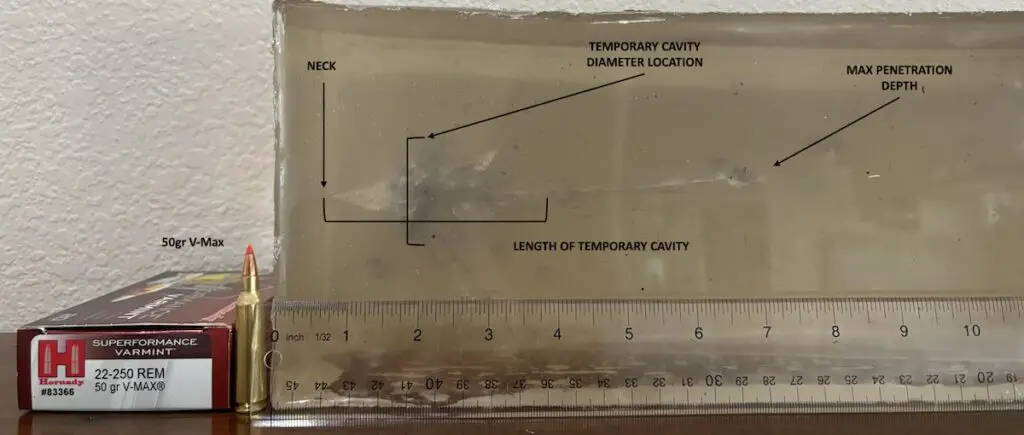
Just like you’d expect with that ammo, it produced a very wide, shallow wound cavity.
Here’s how the 22-250 performed in gel with a 64gr Winchester Power Point that’s better suited for deer hunting:

That bullet penetrated deeper than the V-Max, but delivered a more narrow wound.
Now here’s how the 22 Creedmoor performed with an 80gr ELD-X:
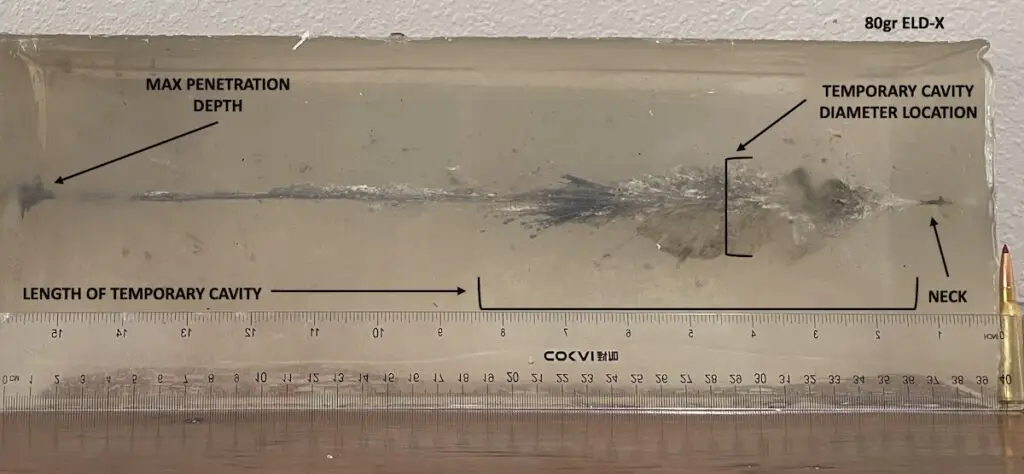
That load made a wound cavity about as wide as the V-Max that was also more than twice as long. Plus, it penetrated significantly deeper than even the 64gr Power Point.
Long story short, the 22 Creedmoor produces a much larger volume wound cavity and also penetrates better than those two 22-250 Remington loads.
How does that translate into performance afield?
Well, I’ve shot two feral hogs and a whitetail deer with the 80gr ELD-X bullets from the 22 Creedmoor. One hog and the deer dropped instantly at the shot and one of the hogs took 2-3 steps before falling over.
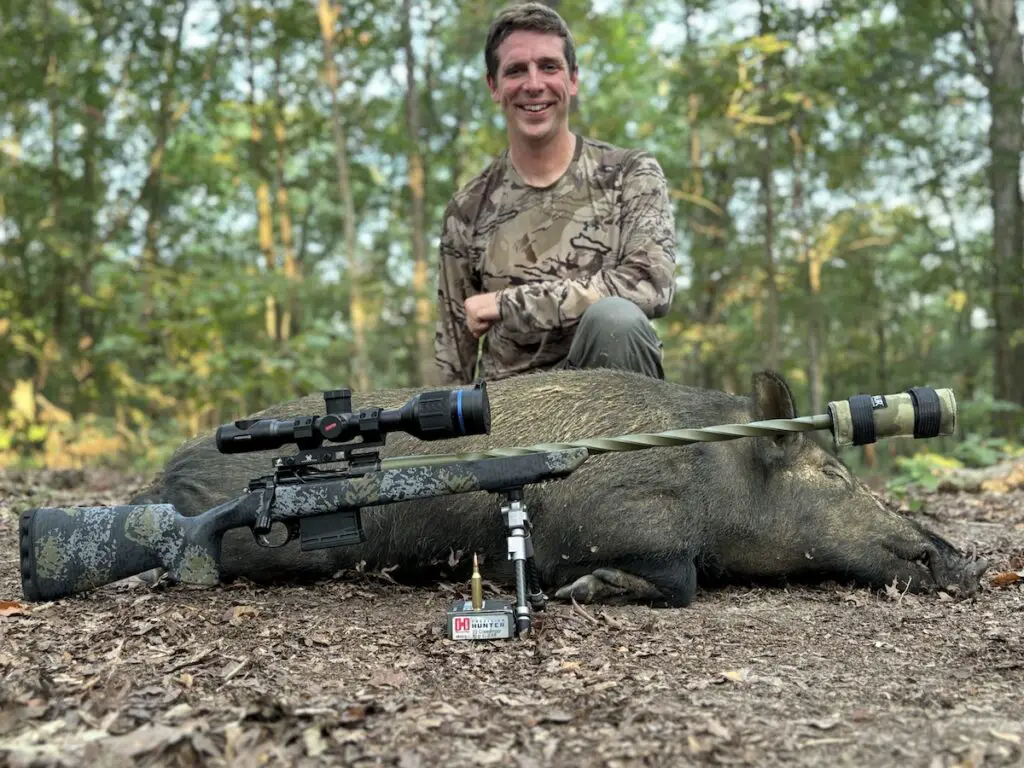
Every single bullet exited the animals after causing immense damage to the vital organs.
22-250 vs 22 Creedmoor Recoil
Now let’s talk about recoil.
The table below compares the recoil produced by a 55gr loads for the 22-250 Remington vs the 80gr ELD-X/ELDM loads for the 22 Creedmoor when fired from identical rifles.
I used handload data from the Hornady reloading manual book (and their online supplement) to get the powder charge info for both loads.
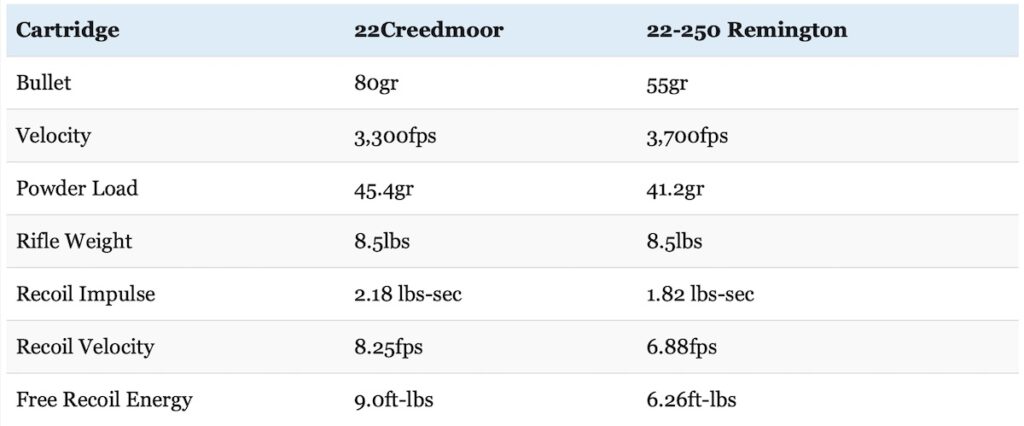
Felt recoil will vary from shooter to shooter and rifle to rifle, but free recoil energy is still a useful way to compare cartridges.
Neither cartridges recoils very much at all, but the 22 Creedmoor has nearly 45% more recoil than the 22-250 Remington in this particular case.
Yes, that’s quite a bit more, but to be perfectly honest, both the 22 Creedmoor and 22-250 also have very mild recoil and virtually any person, regardless of size or age, should be able to handle them with ease.
So where do we stand overall?
22 Creedmoor vs 22-250
The 22-250 Remington fires a lighter bullet at a blazing fast velocity while the 22 Creedmoor fires a heavier and much higher BC bullet at a slightly slower velocity. The end result is the two cartridges have a similar trajectory, but 22 Creedmoor has much more retained kinetic energy, much better resistance to wind deflection, and more recoil.
22-250 vs 22 Creedmoor Ammo
The 22-250 Remington is by far the most popular of the two.
In fact, pretty much every ammunition manufacturer of note like Armscor, American Eagle, Barnes, Black Hills, Browning, Double Tap, Federal, Fiocchi, Hornady, HSM, Nosler, PPU, Remington, Sierra, Sellier & Bellot, and Winchester (just to name a few) produces a wide variety of 22-250 ammo.
Most of those loads use a varmint bullet of some sort and virtually every major style of varmint bullet is available in either a factory load or as a component bullet for the 22-250: the Barnes Varmint Grenade, the Berger Varmint HP, the Hornady NTX and V-Max, the Nosler Ballistic Tip and Varmageddon, the Remington AccuTip V, the Speer TNT, and Winchester Varmint X (just to name a few).
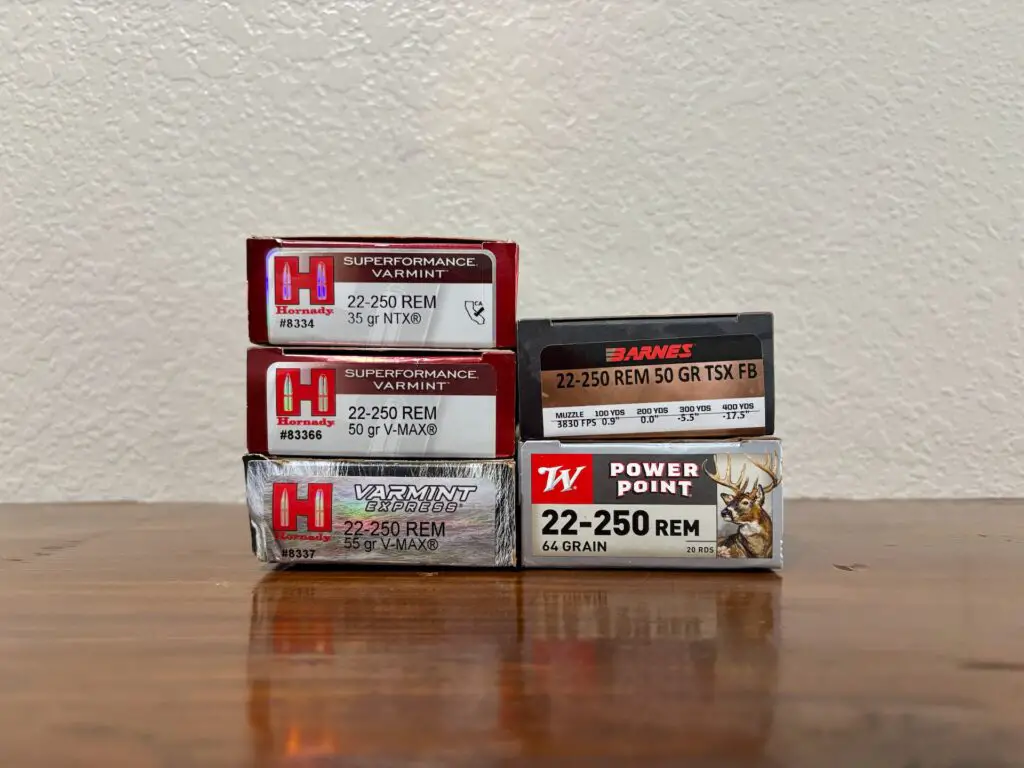
The .22-250 is also available in a few loads designed for big game hunting. For instance, Barnes offers it in their VOR-TX line with a 50gr TSX and Winchester offers it in their Power Point line with 64gr bullets.
Hornady was initially the only company manufacturing factory 22 Creedmoor ammo, but Nosler has also recently picked up the cartridge
Hornady currently offers three factory loads for the cartridge: an offering in their Superformance line firing a 70gr CX bullet, an offering in their Precision Hunter line using an 80 grain ELD-X bullet, and an offering in their Match line using an 80-grain ELD Match bullet.
Nosler produces 22 Creedmoor ammunition in their Trophy Grade line with a 70gr AccuBond and in their Match line with an 85gr Reduced Drag Factor (RDF).
To be fair, handloaders can also use all the 22 caliber component bullets listed above for the 22-250 Remington in the 22 Creedmoor. In addition to all the bullets previously mentioned in connection with the 22 Creedmoor, handloaders can also use a few other bullets that require a fast twist barrel, like the 60gr Nosler Partition, 65gr Sierra GameKing, and 68gr Hammer Hunter.
Those looking for high quality 22 Creed brass can rest easy knowing that, in addition to Hornady and Nosler, Alpha Munitions, ADG, and the Peterson Cartridge Company (among others) all make 22 Creedmoor brass.
22-250 vs 22 Creedmoor Rifles
Once again, the 22-250 Remington easily beats the 22 Creedmoor in terms of rifle availability.
The 22-250 is available in darn near every bolt-action rifle you can think of: Bergara Crest, Bergara Sierra, Howa 1500, Mossberg Patriot, Remington 700, Ruger American, Ruger Hawkeye, Savage Axis, Savage 110, Tikka T3x, Weatherby Vanguard, and Winchester Model 70 (among others).
I’ve shot a Bergara Crest Carbon in 22-250 pretty extensively and really like it.
That rifle utilizes Bergara’s new Cure Carbon barrel and shoots like nobody’s business. It’s a little bit unusual in the 22-250 rifle space in that it has a 20″ long barrel and utilizes a 1:9″ twist rate. That’s an “in-between” twist rate that’s faster than what you’ll traditionally see with the round, but not quite fast enough to shoot the really high BC 22 caliber bullets the 22 Creedmoor excels with.
It really loves the 50gr and 55gr Hornady V-Max bullets though and will shoot darn near a one hole group with both. I’ve also tried it with a handload shooting the 62gr ELD-VT. Accuracy wasn’t as good as with the V-Max bullets, but it also performed reasonably well.
In addition to a great barrel, that rifle also has an ergonomic and lightweight carbon fiber stock with length of pull spacers. Add it all up and you have a lightweight, compact predator rifle that will just flat out shoot.
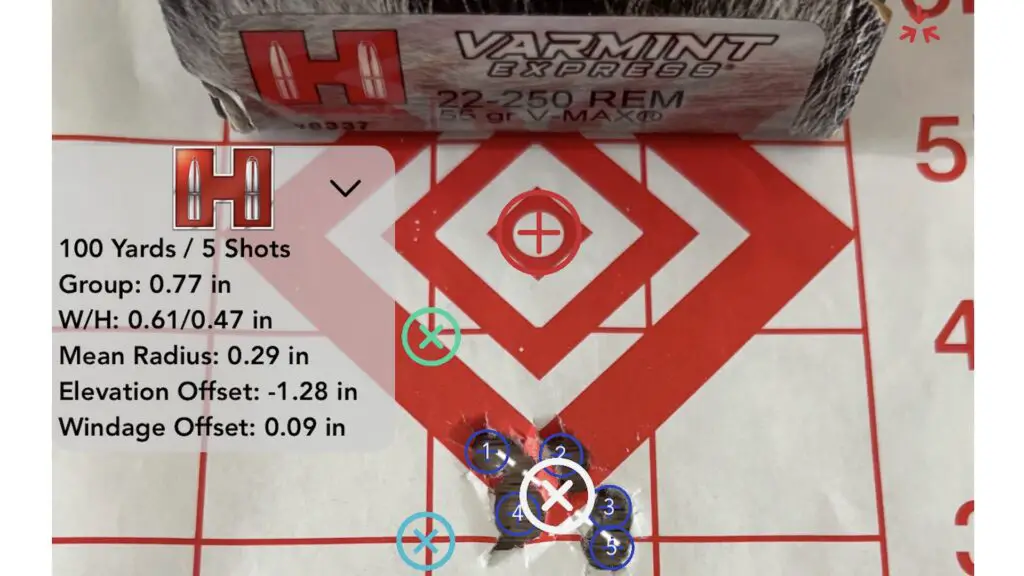
Now let’s switch gears and talk about 22 Creedmoor rifles. Like the 22-250, the 22 Creedmoor is also primarily available in bolt action rifles.
Horizon Firearms offers the cartridge in their Villain, Vandal, and Venatic rifles.
Fierce Firearms also chambers certain models in their Rogue and Rival lines in 22 Creedmoor as well.
Other rifle companies are probably going to start offering the cartridge soon, but that’s basically it for 22 Creedmoor rifles at this instant.
Neither Fierce nor Horizon are known for producing rifles at lower price points either, so the 22-250 is currently the much better choice if you’re on a limited budget.
I have a Horizon Venatic rifle chambered in 22 Creedmoor and it’s fantastic.
They offer the 22 Creedmoor with either a 22″ or 24″ Benchmark barrel with a removable muzzle brake (threaded 5/8-24 TPI) in that model line and pair it with a Stiller Wombat action, a TriggerTech trigger, and a Carbon iota stock. That rifle does have a premium price point, but it’s also an excellent rifle with lots of premium components.
And my goodness does it shoot.
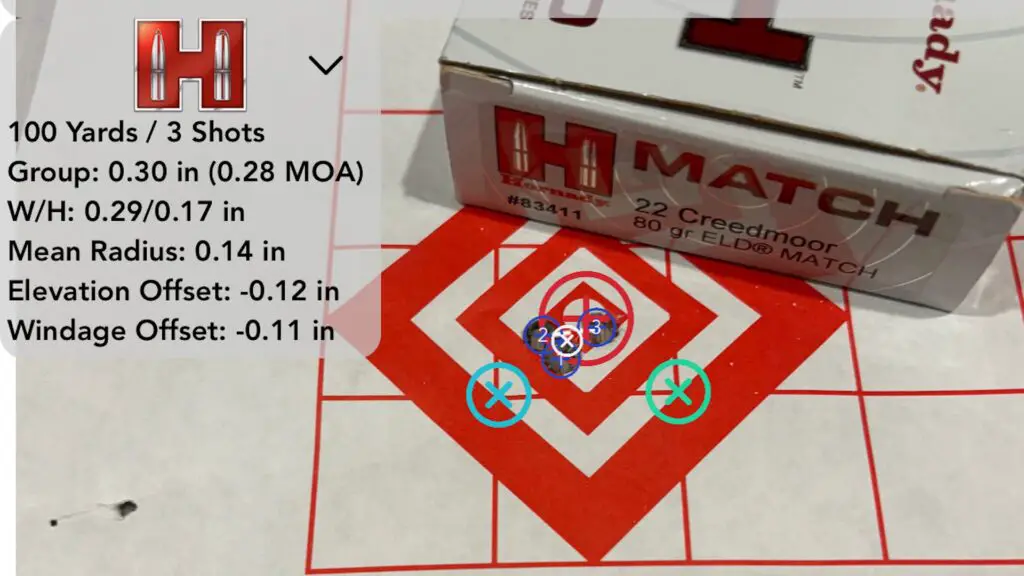
Horizon also offers the 22 Creedmoor in their Villian and Vandal rifles, both of which sport a shorter 18″ barrel in that chambering.
You’ll lose some muzzle velocity by dropping down to a shorter barrel like that (probably down to 3,050-3,075fps with an 80gr bullet), but those rifles are fantastically compact and easy to maneuver.
Continuing along the barrel length train of thought, there’s also quite a bit of overlap with 22-250 rifle barrel lengths. Many have longer 24″ or 26″ long barrels, but some models have 22″, 20″ or even 18″ long barrels.
22-250 vs 22 Creedmoor Barrel Life
Barrel life is a function of several different factors: the quality of the barrel in question, whether or not the user maintains the barrel properly, how “hard” the user runs that rifle (e.g. shooting long shot strings vs letting the barrel cool completely after a few shots), the bore diameter, the powder charge, and the pressure of the ammunition used.
Let’s assume we’re dealing with barrels of similar quality that are used and maintained in a similar manner. If we put those things aside, smaller bore diameters, use with higher pressure loads, and use with larger powder charges are all associated with shorter barrel life.
The reverse is also true.
With those things in mind, the 22-250 and 22 Creedmoor both have the same bore diameter. The 22-250 is a slightly higher pressure round, but the 22 Creedmoor uses more powder.
Jayden Quinlan from Hornady put together a spreadsheet of estimated barrel lives for a wide spectrum of cartridges based on those factors.
He estimated a barrel life for the 22-250 Remington ranging from 950 rounds to 1,777 rounds, with an average of 1,187 shots for hunters using a preponderance of high pressure ammunition vs about 1,481 shots for those using more moderate pressure ammunition.
Basically, you can expect about 1,500 rounds of barrel life if you’re primarily shooting factory loads or moderate handloads in your 22-250 and that will drop down to around 1,200 rounds if you’re shooting lots of spicy handloads.
Though Jayden did not include the 22 Creedmoor in that spreadsheet, Derrick Ratliff from Horizon Firearms stated that Jayden calculated an average barrel life for the 22 Creedmoor of 1,300 rounds for those using hotter loads and about 1,800 rounds for those using factory ammo based on that same criteria.
For what it’s worth, Derrick also stated he had personally seen three different 22 Creedmoor barrels “wear out” and start shooting larger groups around the 1,300, 1,580, and 1,700 round marks, which jives with what Jayden estimated.
That’s a long way of saying the 22-250 and 22 Creedmoor have virtually identical barrel life. Both cartridges are pretty rough on barrels because they’re smaller caliber and higher pressure cartridges.
There’s also no guarantee every single rifle will perform in the same manner here either. Some may experience a drop off in accuracy sooner, while others may continue to obtain great accuracy from a rifle that has exceeded those thresholds, but in general, hunters can expect the best possible accuracy from their 22-250 and 22 Creedmoor rifles that are short of the 1,200-1,700 round mark.
Fortunately, typical barrel life for both cartridges is more than enough to last for many years of hunting with no issues.
22-250 Remington vs 22 Creedmoor: Which Is Right For You?
There’s quite a bit of overlap in their capabilities, but the 22-250 and 22 Creedmoor each have the advantage in a couple of specific areas.
Are you looking for a good all around varmint or predator hunting cartridge? Both the 22-250 Remington and the 22 Creedmoor are outstanding cartridges for hunting predators and varmints like prairie dogs and coyotes.
The 22 Creedmoor has a flat trajectory, performs great in windy conditions, and carries significantly more energy out to extended range, so it has an edge as distances increase. I also think the 22 Creedmoor is a better choice for use on bigger creatures, like coyotes.
In fact, I think the 22 Creedmoor is a nearly ideal choice for coyote hunting. This is especially true for hunters pursuing coyotes at night with a thermal sight and/or in windy conditions (which is often the case for those hunting out west).
It’s tough to obtain an accurate range at night and determining whether you’re looking at a small animal up close or a larger animal farther away can also be tricky through a thermal. However, the fact that the 22 Creedmoor shoots basically as flat as the 22-250, but also performs better in the wind and just flat out hits harder can really come in handy under those conditions.
Those characteristics can make it easier to place shots more accurately on coyotes under certain conditions (especially when it’s windy). Additionally, the 22 Creedmoor is also just more likely to anchor a coyote with even a less than perfect shot.
It works great at shorter range, but the 22 Creedmoor really stands apart from the 22-250 Remington in open country where longer shots are a possibility. As that range increases, the 22 Creedmoor is just more likely to put a coyote down for good, both with solid and less than ideal shot placement.
The same is also true for different shot angles.
Like I mentioned earlier, the 80gr ELD-X produced a longer wound track that was nearly identical in diameter to the one the 50gr V-Max from the 22-250 made in ballistic gel. This can potentially pay some dividends with less than ideal shot placement. The same is also true for a shot on an animal running directly away from the shooter.
Derrick Ratliff demonstrated this on a hunt in New Mexico during 2024 where he scored a coyote double with his 22 Creedmoor. Both dogs instantly dropped at the shot, to include one that stopped and looked back that he had to shoot through the entire length of the body to reach the vitals.

While a hit from a 50gr or 55gr V-Max from a 22-250 will still likely have crippled that animal if it didn’t kill it outright with that shot angle, the deeper overall penetration and longer wound cavity of the 80gr ELDX is more likely to cause devastating damage to the vitals of that animal, kill it faster, and reduce the odds it runs off and dies in the woods where it’s harder to find.
On the downside, I can certainly see the 22 Creedmoor as being rougher on fur than the 22-250. If your goal is to quickly kill a predator or varmint and minimize wounding loss (like during a coyote hunting contest), then this is the round for you.
I would not recommend the 22 Creedmoor (at least not with those 80gr bullets) if I were trying to sell the furs of those animals afterwards.
None of this is to say the 22-250 Remington isn’t a deadly coyote round. Indeed, it remains incredibly effective in that role and is as potent as it ever was on coyotes at extended range. Heck, if anything, improvements in ammunition have allowed hunters to squeeze even more performance out of the case than was possible 50 years ago.
So, I’m not saying it’s a poor choice for that role by any means, it’s just that the 22 Creedmoor has a few advantages.
But what if you’re hunting in an area where you’re unlikely to take a longer shot?
Good question.
The 22-250 is an incredibly flat shooting cartridge itself and doesn’t require much holdover or wind hold inside 300 yards. If you’re hunting in thicker country and shots farther than that are uncommon, then the 22-250 isn’t giving up much to the 22 Creedmoor at all.
Yes, the 22 Creedmoor is still the more potent cartridge, but I’m doubtful you’ll see a significant difference in results if you shoot coyote at 100 yards with a good varmint bullet that has 1,700ft-lbs vs 1,300ft-lbs of retained kinetic energy.
You’re probably looking at a dead dog either way.
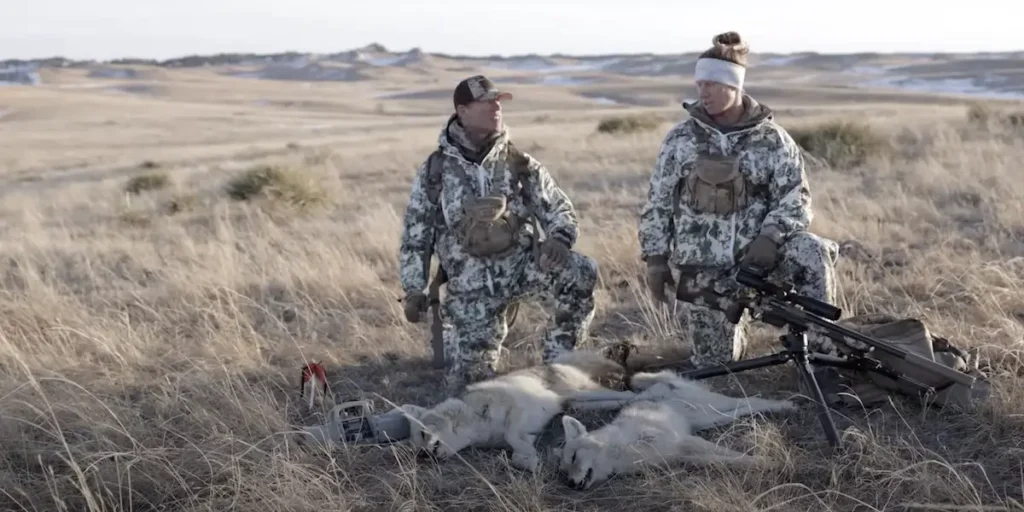
When it comes to hunting smaller animals, like prairie dogs, the 22 Creedmoor’s advantages with wind deflection can really come in handy. Prairie dogs aren’t very big creatures and misjudging your wind hold by as little as 2″ can easily be the difference between a hit or a miss.
Just keep in mind that neither cartridge is ideal for long shot strings. Barrel life is lower for both cartridges than something like a 223 and you can really eat into that more limited barrel lifespan with a few prairie dog hunts where you shoot a bunch of ammo and really heat up your barrel.
Furthermore, the 22-250 Remington has a gigantic advantage over the 22 Creedmoor when you consider the cost, availability, and selection of rifles and ammunition.
The fact remains that there’s a very limited supply of factory loads and rifles (all of which retail for over $2,000) available for the 22 Creedmoor right now. 22 Creedmoor ammo is also about twice as expensive as 22-250 ammo.
On the other hand, you can buy a Ruger American Predator in 22-250, slap a Vortex scope on it, buy some inexpensive ammo from Federal or Winchester for $20-25 a box, and get out coyote hunting for less than $1,000 for everything.
The 22-250 Remington blows the 22 Creedmoor out of the water in this area while still absolutely being “good enough” for use in most coyote hunting situations.
It’s really up to you to determine whether the juice is worth the squeeze.
The 22 Creedmoor certainly offers advantages over the 22-250, but you’ll have to pay extra to get that extra performance.
Do you want a cartridge ideal for hunting big game like feral hogs and deer? First, beware that .22 caliber cartridges are not legal for big game hunting everywhere.
Assuming they are legal to hunt big game where you live, both will work, but I think the 22 Creedmoor is a clear winner out of these two cartridges for hunting big game.
Like I mentioned earlier, that 80gr ELD-X will typically penetrate deeper and make a larger wound cavity than most 22-250 big game hunting loads and I’ve had great results afield with the 22 Creedmoor on deer and hogs.

That being said, the 22-250 can absolutely work in this role too and I know a lot of hunters who have used it as a deer cartridge with success.
I know people have done it, I personally wouldn’t recommend using either cartridge on game bigger than deer though.

Are you looking for a cartridge with lots of inexpensive ammo for target shooting or just fun “general “plinking” at the range?
Neither is a great choice if you want to shoot soda cans in the field behind your house (I’d get a 223 or a 22LR for that), but the 22-250 will be easier on your wallet than the 22 Creedmoor here.
For serious precision shooting at long range, the 22 Creedmoor is the way to go though. That 80gr ELD Match is a wonderful all-around target shooting load and does great out at long range.
Are you very sensitive to recoil? Both are pretty light recoiling, but the .22-250 Remington definitely has less recoil than the 22 Creedmoor. In fact, a lot of smaller and/or more recoil shy hunters use both.
For what it’s worth, the 22 Creedmoor is still a pretty low recoil cartridge. In fact, my 8 year old son shoots my 22 Creedmoor especially well and it’s possible he’ll use it on his first deer one day.
Though the differences between them (22 Creedmoor vs 22-250) are fairly significant in some respects, both are incredibly capable higher velocity cartridges. There’s a fair amount of overlap in their best use cases, but each is also best suited for unique conditions.
For this reason, you should carefully analyze your potential needs before making a decision. In the end, a lot of this decision comes down to personal preference, the exact game you’re after, and the conditions of your hunt. So, choose the one that you feel most comfortable with and it will probably serve you well afield. Good luck!
NEXT: BEST 6.5 CREEDMOOR AMMO FOR HUNTING ELK, DEER, & OTHER BIG GAME
NEXT: BEST GIFTS FOR HUNTERS
Enjoy this article comparing the 22-250 Remington and 22 Creedmoor cartridges? Please share it with your friends on Facebook and Twitter.
Case capacity information for the 22 Creedmoor vs 22-250 were obtained from Chuck Hawks and Rifle Shooter Magazine. I used Shooters Calculator to compare trajectories, wind drift, and recoil for the cartridges. Maximum pressure and cartridge dimensions obtained from SAAMI (here on p66 and p63).
Make sure you subscribe to The Big Game Hunting Podcast and follow The Big Game Hunting Blog on Facebook, Instagram, Twitter, and YouTube.
John McAdams is a proficient blogger, experienced shooter, and long time hunter who has pursued big game in 8 different countries on 3 separate continents. John graduated from the United States Military Academy at West Point and is a veteran of combat tours with the US Army in Iraq & Afghanistan. In addition to founding and writing for The Big Game Hunting Blog, John has written for outdoor publications like Bear Hunting Magazine, The Texas State Rifle Association newsletter, Texas Wildlife Magazine, & Wide Open Spaces. Learn more about John here, read some of John’s most popular articles, and be sure to subscribe to his show: the Big Game Hunting Podcast.

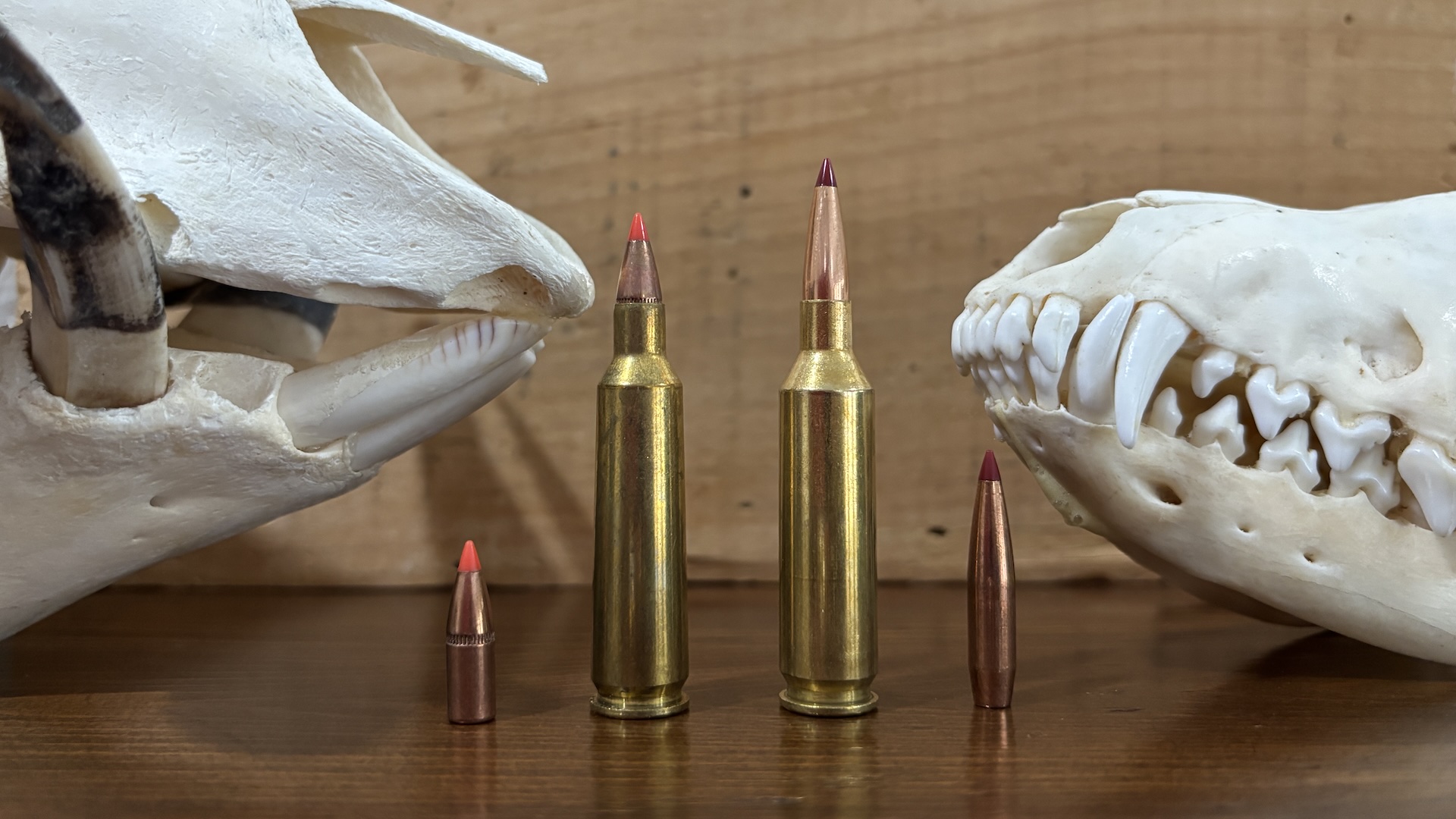

Been using the 22-250 AI for over 36 YEARS. Same or greater case capacity as the new “cartridge of the week”.
Just built another one at low cost using a Savage AXIS action with a Shilen 1-7 1/2 for those really heavy bullets. Works great, and still has the wonderful ability to shoot factory 22-250 loads.
Sorry but I can’t even take you guys seriously. You lack the self awareness to even be properly embarrassed.
Good for you, Daryl. That’s awesome. Building a custom rifle and accompanying handloads like that are indeed very satisfying pursuits. And you are correct that a 22-250 AI with a custom, fast twist barrel delivers performance that’s as good or better than the 22 Creedmoor. But like I say in the article, that’s not something a person can just walk into a store and purchase (same with ammo for it). On the other hand, the 22 Creedmoor is indeed available in factory rifles and ammunition. In fact, Ruger now also offers the cartridge in their American Gen 2 rifle. One isn’t better than the other, you are welcome to use what you want, and I wish you all the best with your pursuits with your 22-250 AI rifles. After all, the cartridge head stamp isn’t nearly as important as the performance it delivers on target and both the 22-250 AI and 22 Creedmoor deliver fantastic results afield and at the range.
John:
Your well crafted and gracious reply speaks well…….especially considering the “get off my lawn” McCrankypants theme of my original comment.
In the…….. for what it’s not worth category………mostly to properly amuse myself, I recently purchased a box of 22 Creedmoor Nosler 85 RDF factory loads. After using a collet style bullet puller, I very minimally sized the outside diameter of the case body inward about 5 thou or so (I even left the neck to shoulder interface in its stock location) I never even messed with the factory powder charge. I re installed the (now somewhat damaged) 85 gr RDF’s to the original overall length. Despite some expected slight resistance to closing the bolt, these fired perfectly, safely and even accurately in the one in seven and half twist Shilen/Savage 22-250 AI. From the 26 inch barrel, these ran the exact speeds specified on the Nosler box. To make things even better, I was then left with some nice looking and perfectly formed 22-250 AI brass with a 22 Creedmoor headstamp. I’m convinced that these very minimally resized rounds would still fire with perfect safety in any 22 Creedmoor factory chamber. If prices come down and availability goes up I may make myself a custom size die to do this, in one step, without even having to pull and re-seat the original bullets. Life is good for shooters and reloaders these days, but there’s really never anything new under the sun.
Nothing new under the sun indeed, Daryl. Another reader was telling me the other day how he thinks the 250 Savage is the real parent case to the Creedmoor family. I told him he was partially right. There are lots of minimal changes around the edges, with body taper, with shoulder angle, with various aspects of the chamber design with new cartridges, but it’s especially interesting to me how that same .473″ case head diameter and some other general design principles from the old 7x57mm Mauser are still turning up everywhere these days…